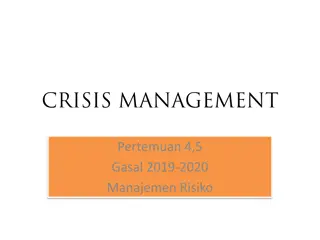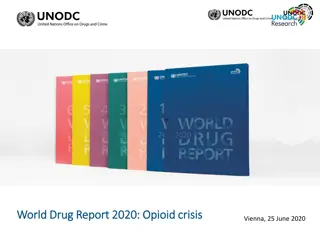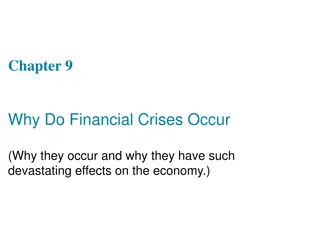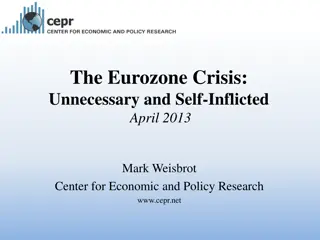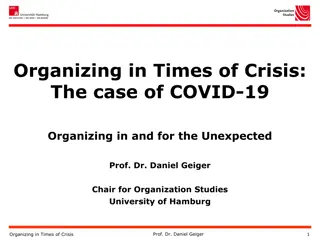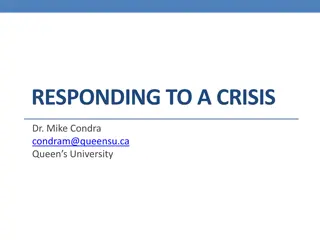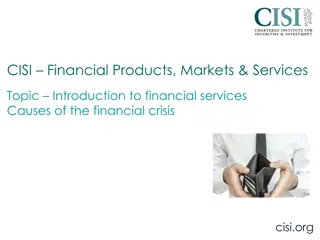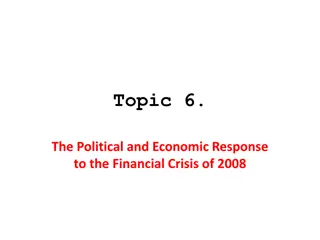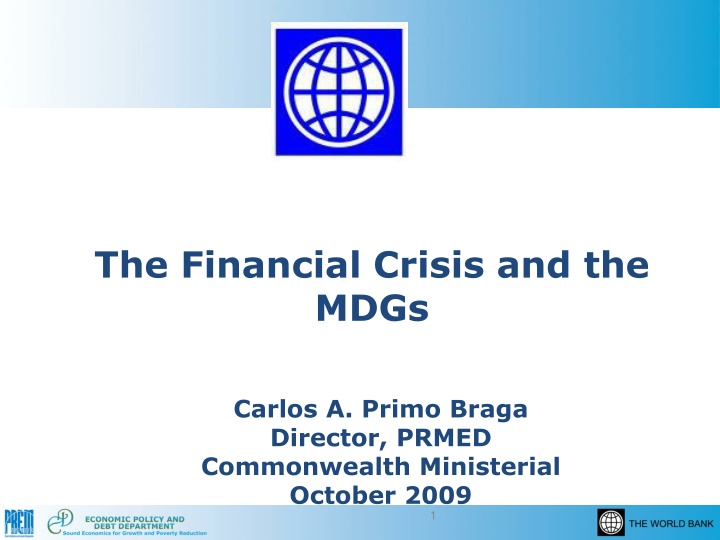
The Financial Crisis and the MDGs
The financial crisis, antecedents, and its impact on developing Commonwealth countries are explored in this presentation. Main transmission channels affecting developing countries, regulatory changes, and the decline of capital flows are discussed.
Download Presentation

Please find below an Image/Link to download the presentation.
The content on the website is provided AS IS for your information and personal use only. It may not be sold, licensed, or shared on other websites without obtaining consent from the author. If you encounter any issues during the download, it is possible that the publisher has removed the file from their server.
You are allowed to download the files provided on this website for personal or commercial use, subject to the condition that they are used lawfully. All files are the property of their respective owners.
The content on the website is provided AS IS for your information and personal use only. It may not be sold, licensed, or shared on other websites without obtaining consent from the author.
E N D
Presentation Transcript
The Financial Crisis and the MDGs Carlos A. Primo Braga Director, PRMED Commonwealth Ministerial October 2009 1
Presentation outline The financial crisis in a nutshell Implications for industrialized and developing economies The MDGs and the crisis Performance of Developing Commonwealth Countries Concluding remarks 3
A Tale of Two Depressions Source: Eichengreen & O Rourke (2009) 4 9
The crisis in a nutshell Antecedents of the crisis: Boom-bust credit boom, fueled by lax monetary policy in developed countries An asset price bubble and excess investment in real estate (poor assessment of risks) Poor corporate governance Macroeconomic imbalances 5
Additional considerations Opaqueness of new financial products -- Reckless use of collateralized debt obligations -- Growing reliance on the originate-to-distribute business model/poorer risk assignment Financial integration -- Much larger capital flows /cross-border positions Major regulatory and supervision changes --The repeal of Glass Steagall (1999) to allow US conglomerates to leverage their balance sheets like EU universal banks; transition from Basel I to Basel II; SEC ruling on net capital (2004)
Developing Countries: Main Transmission Channels Financial sector effects impact on domestic financial sector and sophisticated firms Liquidity squeeze and lower risk appetite higher financial costs Lower commodity prices and trade volumes lower export proceeds and government revenues Reduction in capital flows and remittances tightened financial sources 7
Relative to past downturns the decline of capital flows has been even more dramatic Net private capital flows / GDP in developing countries Projection 2007-10 Percent Percent 1997-02 1980-83 Source: DECPG/GDF ; World Bank (2009a)
Private capital flows are unlikely to recover to pre-crisis levels for some time US$ billion 1600 percent Net Private Capital Flows to Developing Countries 10 9 8 1200 7 6 Percent of GDP (right axis) 800 5 4 3 400 2 1 0 0 1995 1998 2001 2004 2007 2010p 2013p
The current crisis, however, will not be a rerun of the Great Depression (Source: Brahmbhatt and Pereira da Silva, 2009) Larger weight of developing countries in the world economy (24% in 2008 vs. 13% in 1929) plus decoupling of underlying trend rates of growth (growth gap = growth in Developing Countries growth in ICs = 0.8 % in the 1990s/3.5% in 2000- 08); Larger share of services in global activity (employment in services less volatile); Changes in the structure of world trade (greater elasticity of trade with respect to GDP); Different policy responses: monetary, financial sector, trade and fiscal policies. 10
A recovery is underway, but is relatively weak, uneven, and subject to considerable risks (Source: DEC) Real GDP growth rates (%) 10 World High-income 8 Middle-income Low-Income 6 Sub-Saharan Africa 4 2 0 2000 2002 2004 2006 2008 2010 -2 -4
The crisis has hurt medium-term growth prospects with high excess capacity and unemployment continuing for several years (Source: DEC) Output gap (% of potential GDP) 4 2 0 -2 -4 High-income Middle-income Low-income -6 -8 1990 1993 1996 1999 2002 2005 2008 2011 2013
Poverty impact of the growth slowdown is large and rising (Source: DEC) Increase in number of poor (millions) 140 120 120 100 89 80 2009 2010 64 60 50 40 20 0 US$ 1.25/day US$ 2.00/day
Growth collapses are costly for human development outcomes the MDGs, already in jeopardy, face further setbacks Serious shortfalls on most human development MDGs; prospects are gravest in health. Sub-Saharan Africa is falling short on all MDGs. South Asia lags on all human development MDGs. Achievement of the poverty reduction MDG also is now threatened. % of goal 100 90 80 70 60 50 40 30 20 10 0 MDG1.a: Extreme poverty MDG1.c: Hunger MDG2: Primary education MDG3: Gender parity Needed to be achieved by 2007 to be on track MDG4: Child mortality MDG5.a: Maternal mortality MDG7.c: Access to safe water MDG7.c: Access to sanitation Achieved by 2007
Tracking Progress on MDGs in 143 Developing Countries: Most countries are falling short on most of the MDGs (# of countries) MDG 7.c: Access to sanitation 17 11 23 75 17 MDG 7.c: Access to safe water 47 18 19 49 10 MDG 4: Child Mortality 7 25 70 39 2 MDG 3: Gender Parity 81 13 8 18 23 MDG 2: Primary education 46 7 15 37 38 MDG 1.c: Hunger 16 12 25 30 60 MDG1.a: Extreme poverty 20 23 12 28 60 0% 20% 40% 60% 80% INSUFFICIENTDATA 100% ACHIEVEDTARGET ON-TRACK OFF-TRACK SERIOULSYOFF-TRACK Data Source: World Bank (2009b) 15
MDG shortfalls are more serious in low- income countries, especially in fragile states The challenge to achieve the MDGs will increasingly be concentrated in these countries
Outlook for the MDGs in the Developing Commonwealth Countries (# of countries) 100% 5 6 8 8 90% 9 17 80% 4 15 26 70% 3 20 60% 5 17 9 50% 30 40% 2 3 3 1 6 2 30% 22 4 24 5 20% 15 13 11 4 10% 3 1 3 1 2 1 0% MDG1: POVERTY MDG2: PRIMARY EDUCATION MDG3: GENDER PARITY (PRI. & SEC.) MDG4: CHILD MORTALITY MDG5: MATERNAL HEALTH MDG7: 1- WATER MDG7: 2- SANITATION INSUFFICIENT DATA SERIOUSLYOFF-TRACK OFF-TRACK ONTRACK ACHIEVED TARGET Data Source: World Bank (2009b) 17
Poverty Reduction Goal in Developing Commonwealth Countries (# of countries) 60% 10 40% 6 8 5 7 20% 1 4 4 4 3 2 1 0% -20% -21 -26 -30 -40% -60% -80% POVERTY POVERTY (NATIONALLINE) MALNUTRITION INSUFFICIENTDATA SERIOULSYOFF-TRACK OFF-TRACK ON-TRACK ACHIEVEDTARGET Data Source: World Bank (2009b) 18
Tracking Progress on MDG3 (Gender Parity) Developing Commonwealth Countries (# of countries) 100% 6 80% 4 8 4 3 1 60% 5 7 7 40% 24 22 21 20% 13 0% -5 -7 -8 -20% -31 -40% -60% -80% GENDER (PRIMARYAND SECONDARY) INSUFFICIENTDATA GENDER (PRIMARY) GENDER (SECONDARY) GENDER (TERTIARY) SERIOULSYOFF-TRACK OFF-TRACK ON-TRACK ACHIEVEDTARGET Data Source: World Bank (2009b) 19
Child Mortality/Measles Immunization Developing Commonwealth Countries (# of countries) 100% 80% 15 16 60% 4 40% 6 22 20% 12 1 1 -5 0% -6 -20% CHILDMORTALITY MEASLESIMMUNIZATION INSUFFICIENTDATA SERIOULSYOFF-TRACK OFF-TRACK ON-TRACK ACHIEVEDTARGET Source: World Bank (2009b) 20
Access to Safe Water and Sanitation in the Developing Commonwealth Countries (# of countries) 100% 80% 20 60% 30 40% 3 4 20% 11 3 1 2 0% -6 -8 -20% Water Sanitation Insufficient data Serioulsy off-track Off-track On-track Achieved target Source: World Bank (2009b) 21
Responding to a development emergency: priorities for action Ensure an adequate fiscal response to support growth and protect the poor consistent with maintenance of macroeconomic stability Improve the climate for recovery in private investment including paying special attention to strengthening financial systems Redouble efforts toward the human development goals including leveraging the private sector role Scale up aid to poor and vulnerable countries Maintain an open trade and finance system including action on the Doha Round Ensure that the multilateral system has the mandate, resources, and instruments to support an effective global response to the global crisis
Avoiding a protracted recession calls for a globally coordinated fiscal stimulus in both developed and developing countries Developing countries fiscal needs are rising but fiscal space is narrowing fiscal positions will weaken on average by more than 2% of GDP in 2009 Expenditure priorities include social safety nets and infrastructure Enabling an adequate fiscal response in developing countries through appropriate financing will be a win-win for all Fiscal response needs to be tailored to country circumstances Deterioration in developing country fiscal balances, 2009 Percent of GDP 0 -1 -2 -3 -4 -5 -6 Middle East & North Africa South Asia Latin America & Caribbean East Asia & Pacific Sub- Saharan Africa Europe & Central Asia
G20 countries fiscal stimulus and financial sector support Advanced economies: Average discretionary fiscal expansion in 2009: 1.5% of GDP Average financial sector support: 5.4% of 2008 GDP Emerging economies: Average discretionary fiscal expansion in 2009: 2.0% of GDP 1/ In percent of 2009 GDP. Excludes below-the-line operations that involve acquisition of assets. 2/ As of Apr. 15, 2009, in percent of 2008 GDP. Consists of capital injection, purchase of assets and lending by Treasury, and central bank support provided with Treasury backing. Source: IMF 24
Government Debt: Medium Term Prospects (Source: IMF, 2009) Significant expansion of public debt in advanced economies Debt/GDP 2007 2009 2014 Advanced G20 77.6 100.6 119.7 Emerging G20 37.8 38.8 36.4 USA 63.1 88.8 112.0 Japan 187.7 217.4 239.2 UK 44.1 68.6 99.7 Korea 33.0 35.8 39.4 Brazil 67.7 70.1 62.2 China 20.2 20.9 21.3 India 80.4 83.7 73.4 Indonesia 35.1 31.1 28.4 25
External financing from official sources will need to rise substantially Developing countries face large external financing gaps in 2009, as private flows will fall well short of financing needs ECA LAC SSA SAS EAP MNA ECA LAC SSA SAS EAP MNA -50 -50 -150 -150 -250 -250 Low case Short-term debt due Base case Long-term debt due -350 -350 Current account External financing gaps External financing needs -450 -450 US$ (billions) US$ (billions) ECA=Europe & Central Asia; LAC=Latin America & Caribbean; SSA=Sub-Saharan Africa; SAS=South Asia; EAP=East Asia & Pacific; MNA=Middle East & North Africa.
Developing countries will face large financing gaps into the medium term (= current account balances principal repayments on private debt vs. private sources of external financing) US$ billion 1200 External Financing Needs 1000 800 600 External financing needs 400 200 Financing gap 0 2009 2010 2011 2012 2013 Note: Includes 59 countries with financing gap; Source: World Bank (2009a)
Domestic resource mobilization must also be strengthened Even in Sub-Saharan Africa, with a relatively high dependence on official assistance in many countries, domestic revenue on average constitutes more than 70% of public resources for development Development finance in Sub-Saharan Africa US$ (billions) 350 300 250 200 150 100 50 0 2002 2003 2004 2005 2006 2007 Domestic revenue Private flows ODA
Looking Ahead: Globalization Revisited (adapted from Leipziger, 2009) The crisis impacts economic thinking in a moment of transition: from the triumphalism of the End of History to the new emerging consensus around the messages of the Growth Commission It is recognized that the global economy is unlikely to return to the boom conditions which prevailed shortly before the crisis Environment of large capital flows, low interest rates, and strong growth in trade will not return for a while Changes in the roles and regulation of financial market participants will be profound Government will have a much larger role in the overall economy, with implications for short-term and long-term growth Skepticism about globalization will be more pervasive, with increased perceptions of risk across the spectrum of trade and investment activities The crisis will accelerate a significant rethinking not necessarily of the overall merits of globalization but of how to better harness it for development ends Notably, there has not yet been a significant turning away from globalization by developing countries, which is important The appetite for multilateral solutions, however, has increased 29
A protracted crisis? Recessions, Crunches, and Busts Output Trajectory During U.S. Recessions Recessions Output Trajectory During US Recessions (Pre-recession Output Peak = 1, at time = 0) Credit Crunches 1.04 46 10 Average of 7 previous recessions 2008:2 1.02 1981 Recession 1 3 1973 Recession 1.00 4 18 31 3 1 9 0.98 J.P Morgan forecast through 2010:1 House Price Busts Equity 0.96 Price Busts -2 -1 0 1 2 3 4 5 6 7 Quarters before and after the peak Source: Claessens, Kose, Terrones (2008) Source: JP Morgan Current crisis is one of four of the past 122 recession to include a credit crunch, housing price bust, and equity price bust Average of past US recessions has shown that it has taken 5-6 quarters before pre-recession output levels were regained; current recovery will take longer 30
Concluding remarks Slower world economic growth and higher cost of capital will mean a more difficult environment for developing countries seeking to accelerate growth and progress toward the MDGs. In this environment, countries efforts to enhance efficiency of resource use and improve productivity will be even more important. Financial crisis: scale of policy responses is country specific, but, given the procyclicality of the financial system, it is important to coordinate financial sector reform and to synchronize macroeconomic responses; The severity of the downturn highlights the need for an increase in high- impact fiscal expenditures. But embedding stimulus packages in a credible medium-term strategy, that safeguards fiscal sustainability, is key; Expansion of public debt will be massive. Countries need to design exit strategies to the ongoing fiscal interventions and to introduce growth-enhancing reforms to reassure markets of the public sector s solvency. This is even more critical for those facing significant fiscal pressures associated with aging-related spending; Debt sustainability implications for LICs: a function of the crisis duration. Implications of non-concessional borrowing need to be carefully evaluated; Debt management: the crisis further underscores the importance of debt management practices and makes the Debt Management Facility even more relevant;
Concluding remarks (cont.) Beyond 2015: climate change; infrastructure needs; global vs. country targets; fragile states WBG response: increase in IBRD lending (mix of Development Policy Loans (budget financing/fast disbursing: financial sector restructuring; contingent source of liquidity...) and Investment Loans (preserving infrastructure spending; support for clean technology; social safety nets...)); fast-tracking IDA funds; Vulnerability Financing Facility; INFRA (support for infrastructure); guarantees via MIGA; new IFC facilities (support for trade; recapitalization of banks; refinancing of microcredit institutions); the Debt Management Facility. World Bank Group Commitments fiscal years 2009 and 2008 (in U.S. billions) World Bank Group IBRD IDA IFC MIGA TOTAL FY09* 32.9 14.0 10.5+ 1.4 58.8 FY08 13.5 11.2 11.4+ 2.1 38.2 *Unaudited numbers as of July 1. +Own account only. Excludes $4.5 billion in FY09 and $4.8 billion in FY08 mobilized through syndications and structured finance.
References Brahmbhatt, M. and L. Pereira da Silva (2009) The Global Financial Crisis: Comparisons with the Great Depression and Scenarios for Recovery PREM Note 141; Claessens, S., M.A. Kose, and M.E. Terrones, (2008) What Happens During Recessions, Crunches and Busts? SSRN Working Paper Series, December; Eichengreen, B. & O Rourke, K. (2009) A tale of two depressions , VoxEu, (updated) 06/04/09; Leipziger, D. (2009) Presentation on the findings of the Growth Commission; World Bank (2009a) Global Development Finance: Charting a Global Recovery; World Bank (2009b) Global Monitoring Report 2009: A Development Emergency. A report prepared jointly by staff of the World Bank and the International Monetary Fund. 33

